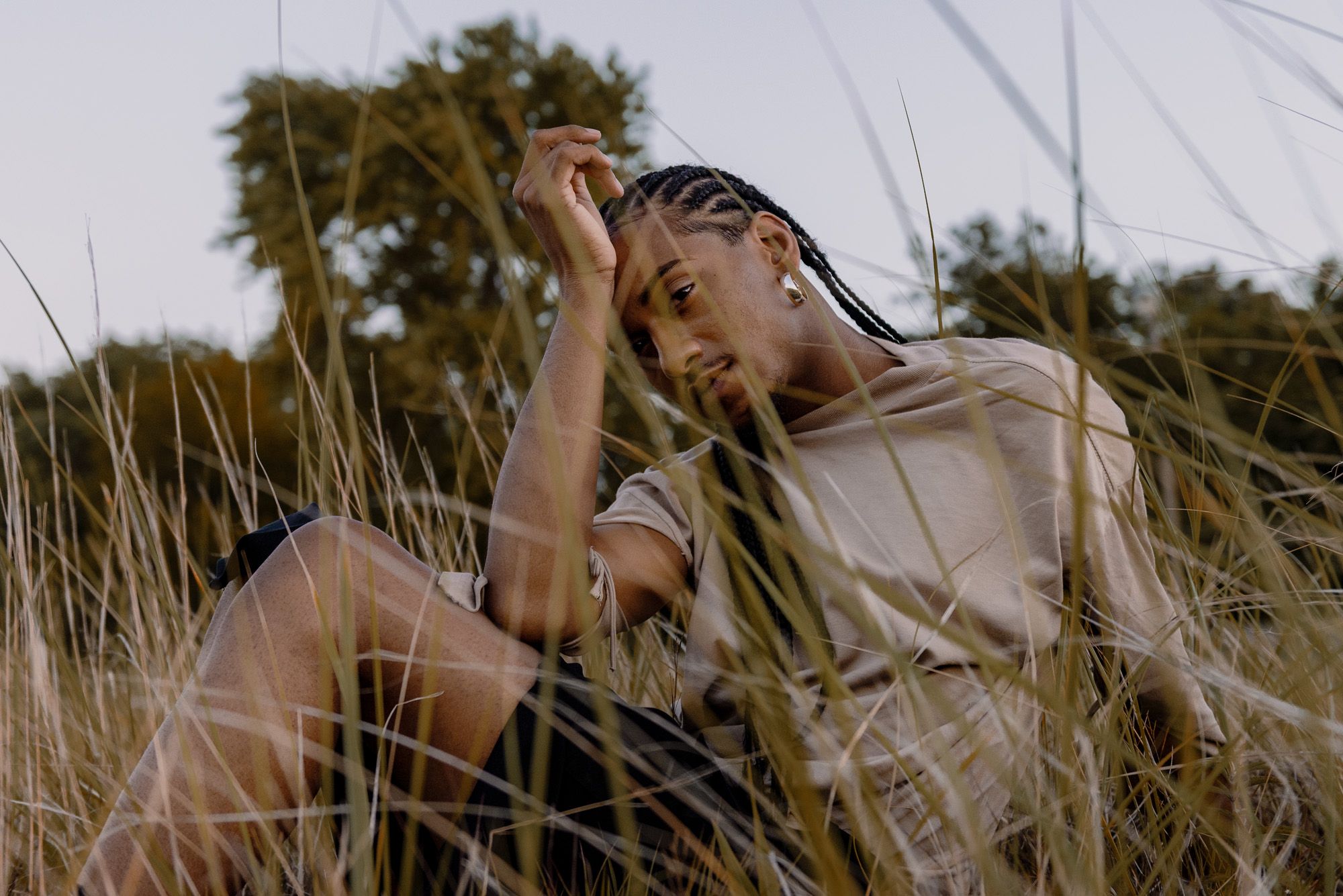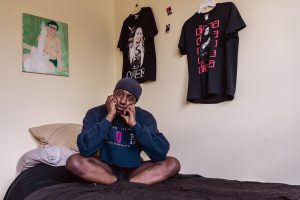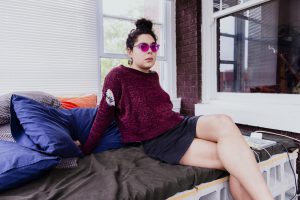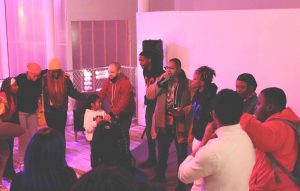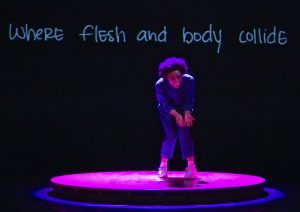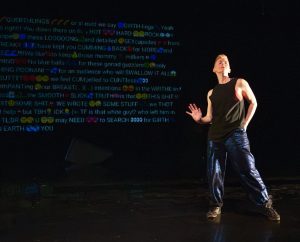DJing is a curious art form and rarely discussed as one. It is rarely discussed at all, except by other DJs in industry publications––what is there to say that can’t be expressed more vigorously on the dancefloor? If you’re talking, you’re not dancing, and you’re probably standing in the way of people trying to dance. Is it art? It’s entertainment, it’s a trade, it’s a party. I hear André Leon Talley in the documentary “Catwalk” wrinkling his nose at a parallel question about that other commercial art form: “No, no, no. Is fashion art? No! Fashion is hard work, gritty; it’s not glamorous”—the question is an embarrassment to both art and fashion. Or DJing.
To consider the question at all means that the answer is at least “sometimes.” DJing is work in the realm of aesthetic experience; it is a discipline with a touch of wonder and mystery and creative talent. DJs hear what others don’t, they surprise us with a blend, they tell a story, they improvise, they observe the energy of a room in order to transform it; they work with field recordings, sound archives, and performance. But it’s a moral question, too: does it have an aura, does it do the sacred creative work of imagination, of memory, of liberation?
There’s no point to proving that DJing is an art, unless doing so adds to our understanding in some way. So, we talked. With DJs Ariel Zetina, Miss Twink USA (Del Hale) and Morenxxx (Jesús Hilario Reyes). I asked about what drew them to DJing, the decisions that factor in selecting and sequencing tracks, and their research process. Those questions turned into conversations about memory, pop culture, narrative form, sonic dominance, queer life, diaspora, history, and ritual. The three DJs draw on practices of performance, theater, poetry, and sound art. They incorporate field recordings, sound archives, memes, reality TV into the mix. They articulate time and space: a Beyoncé sample over an ‘80s house track, a field recording from Puerto Rico played over a UK club track in Chicago, a Brazilian baile funk song blended into Detroit techno.
Accompanying the written Q&As is a mixtape, “Art of DJing: House of Zetina,” that samples the audio from our interviews––an experiment in the form of the DJ mix, in using the techniques of DJing and music production to collage a conversation.
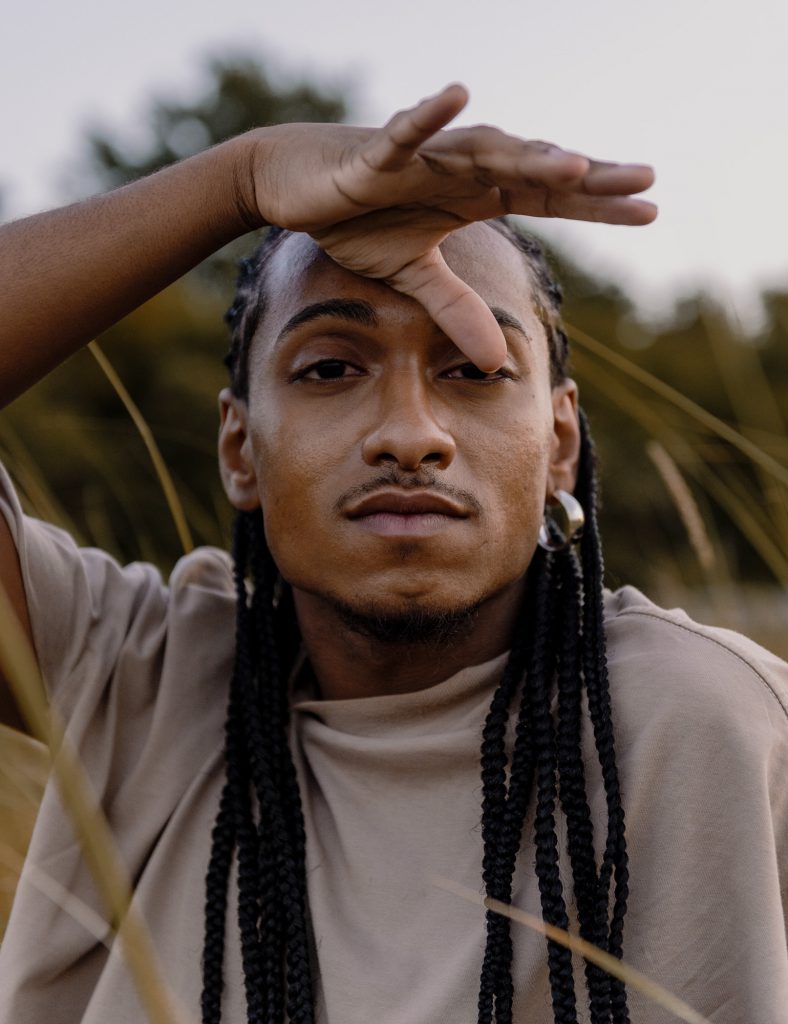
Morenxxx (Jesús Hilario Reyes) is a DJ, performer, and sound and new media artist. “Sonic dominance” is a guiding motivation of their live sets, which draw on the aesthetics, sounds, and cultural practices of their Caribbean roots.
This interview has been edited for clarity and length. Morenxxx uses they/them pronouns.
Sasha Tycko: What drew you to DJing?
Morenxxx: I think there’s two parts of this. Initially, I would go to a lot of house parties and I was not satisfied with the music selection. I would often times take the aux cord and have multiple music apps on my phone and try to play them at the same time. So, kind of blend a little bit. Which didn’t really function that well. I also had a DJ app on my phone that I would use but I think I started to really think about DJing after I started to make film—or video. I started to experiment with sound much more visually. I went out a lot so it just ended up inevitably happening whern I was asked to DJ this party at —I forget what it was called. It was with my friend CDVR. It was a while ago. I started DJing from there.
Initially, I think I was more concentrated on making people dance and playing bops or something like that. But further on, when my [art] practice started to marry into this nightlife, I think that’s when I started to take it much more experimentally or much more conceptually.
ST: I feel like a lot of DJs start like you said. Not actually knowing how the technology works. Just trying to make something work, like just copying and pasting stuff on GarageBand or like blending between iTunes and Spotify or whatever. How did you actually learn the technology and overcome that—there’s something kinda mysterious about how to DJ—how did you actually start to learn?
M: My friend told me about VirtualDJ—a lot of people start on VirtualDJ. A lot of people start on that software. So I just started playing around with that and from there I bought a controller. That controller right there [points toward something leaning against their bedroom wall]—I forget what it’s called—yeah, a Serato controller. I bought the controller and that’s how I figured out how to use the technology. It was like VirtualDJ but on a physical interface. From that I transitioned into CDJs. And who was on that show—yeah it was CDVR again. She was working on my school’s radio station and she gave me my first lesson on CDJs. At first it was like—I can’t, this is a lot. I couldn’t figure out how to cue on beat, ‘cause I wasn’t used to making that four-count. Just thinking about the count and really listening to the bass to figure out where to blend. So at first, I was like, this is a lot. I don’t remember when it just clicked but it inevitably clicked. From there it was much easier. I learned to use older CDJs that don’t have the wave form available so you don’t depend on the visual. Because I think that’s something that’s kind of spoiling you in a way.
ST: And then it’s harder to switch to different equipment.
M: Yeah. So—what was the question again? Yeah, that’s how I learned to use CDJs or VirtualDJ. I still use that controller to record my mixes. ‘Cause it’s the same thing as the CDJ. It’s just not as robust. I use Rekordbox to record my mixes. Which is basically the same thing as VirtualDJ. I feel like all the DJs all do the same thing. They all cost the same too.
ST: How do you describe your style now? DJing wise.
M: I feel like right now I’m trying to carve out my own specific sound. I’ve been really looking to find what that is ‘cause—I don’t know, I think I try to maintain this—I play a lot of techno, tribal techno, I play a lot of reggaeton and Caribbean music mixed in with techno. I think I look for these political narratives in the music that help me communicate some type of story. In terms of baile funk, techno and reggaeton—all of those coming from environments that are very inhospitable to the people that make that music. I generally like to lean towards those types of sounds. I like that type of language. I would say experimentally—I have field recordings I take from. I am also a sound artist. I use a lot of my sound archive and my mixes to transform space. I did a live set at Rumors Limited Edition—it was, like, I don’t know, it was kinda wild ‘cause I had these smoke grenades that I used during my set and they kinda blinded people. So people went outside because it was too much. I didn’t really think about that in that type of enclosed space. But in the way it that transformed space—I was trying to practice sonic dominance, which is something I was reading. There’s this book called ”Sonic Warfare” [and] there’s this chapter on sonic dominance where the sound is– basically hearing is the most utilized sense in the space. I was trying to use that.
ST: In the space of the club?
M: Yeah in the space of the club or even outside the club. I think it was in relation to baile funk and how that is a space of sonic dominance because they have those huge tower speakers that engulf the audience. I think my sound– I’m still trying to figure out my own language for it right now but I would say it’s kind of dark something. But I can also give other things.
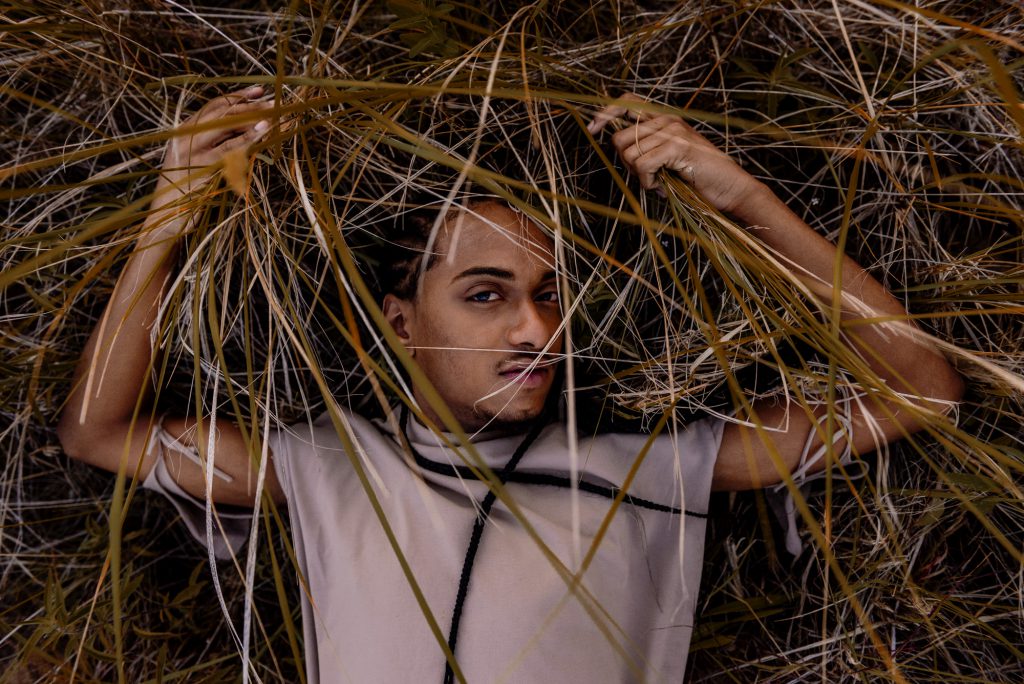
ST: You said you’re playing these genres of music that originate from spaces that are inhospitable to the people making that music. What is it doing to play those sounds in Chicago?
M: I think there is a large conversation being had, unconsciously but also consciously, throughout the diaspora and I think they all relate to one another. Even in Chicago there’s footwork and house music, and how those also are in conversation with those others—techno, baile funk, reggaeton, dembow and all of those sounds. They’re all in conversation.
In the film I’ve been working on with my friend Leah—there’s this sample that we got from an interview with Saidiya Hartman. She’s talking about much of what contemporary Black art is doing is noticing the enclosure is brutal and a lot of people are trying to produce an outside. And I think that’s what I’m trying to do in the sounds I’m engaging with, is to produce an outside. Because I think that in those spaces—like a rave—those are the spaces that queer people of color are able to really dissociate in and really be allotted some sense of liberation or freedom. So I think about all of those things very, very intentionally in the songs I try to pick out. I can’t say that for all of my sets because as a DJ, sometimes you get booked for things that aren’t so aligned with that type of mentality but are more about making people dance. But when I have the chance to really delve into the more political aspect of it, I definitely want to explore that more.
I think that’s how I engage with all of those sounds in Chicago. Even the police system here—the overall state of inequality, I’m not trying to center that. I don’t think the music centers that. I think the music centers what it centers, liberation, dance and all of the good things, euphoria.
ST: How do you select and use field recordings?
M: A lot of the field recordings I’ve been using are atmospheric sounds. I’m always trying to bring people to the Caribbean. I have this big sound archive of field recordings of like maybe just walking down the street and there’s a lot of coquí sounds, which is the indigenous frog of Puerto Rico. In the recent mix of mine, the Jerome Mix Files, I use a field recording of this preacher—it’s a really intense field recording. The preacher was across the freeway. Where my cousin lives, there’s a freeway in the middle that separates the two parts of the neighborhood. Not a lot of people drive through there. There’s a gated community and they were having some sort of sermon and she was yelling over the megaphone. I’m envisioning it, cause I wasn’t physically in the space, I was across the street. But she was preaching over a man who wanted to kill himself. She was telling a story. I was thinking a lot about death and rebirth and how they change your life so quickly.
Recently a really really good friend of mine passed away. So that mix was trying to negotiate death in all these different ways and trying to extract them. And also just thinking about how even in those moments of despair we’re able to feel so many other things because it’s not so—I guess not so concrete—it’s much more fluid. There’s these ins and outs. And in that mix, I think I have these ins and outs of bliss, rage and everything in between.
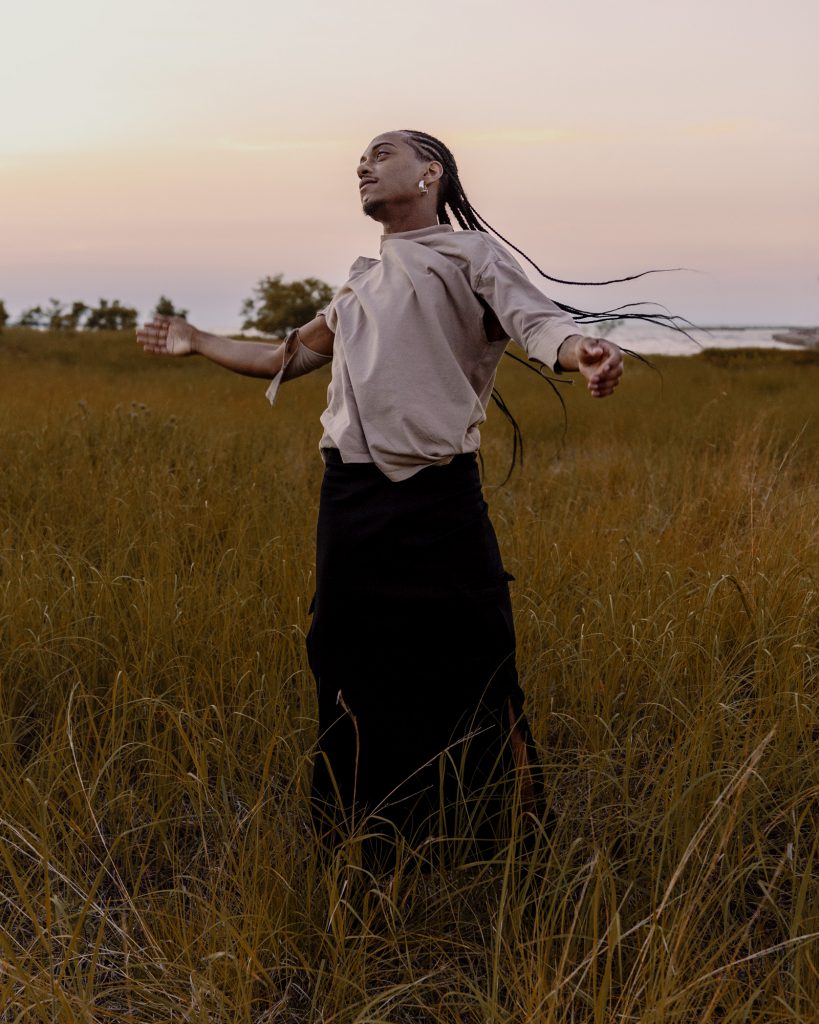
ST: Are you thinking about these sets in terms of how they affect you personally? Did that help you heal in some way? And more broadly, do you think as a DJ you’re always ultimately playing for a group of people? How much of yourself are you centering in your mix?
M: Yeah. That’s true. That’s a good question. I think, honestly, I think I center myself a lot in my mixes. At least the mixes that exist online. When I’m playing at a club, I think there’s a level of improvisation that I have to maintain. You never know if the audience is not feeling it. So I have to be conscientious of what I’m playing and how the audience is behaving. So even if I go into a space with a set prepared, I try to leave room for those moments of improvisation where the mix could be completely different. I think that’s important as a DJ, to be able to think on the go and not be so stuck on a certain pattern. I recently had a conversation with one of my mentors. They were saying I shouldn’t be afraid to go off beat as long as it’s rewarding. I think that that is important. A lot of us really try to be like—this has to be on beat. If it’s off beat then it’s not working. But I don’t think that’s necessarily true. I think you’re working with the audience to get somewhere else. So I’ve been trying to rewire my thinking of mixing in that type of language.
I recently went to a set in New York, I was just in New York. Total Freedom was playing—I’ve always listened to Total Freedom, I’ve always liked his music— that was one of the craziest sets I’ve heard honestly. He was able to maneuver through all these different genres so effectively. I was really trying to figure out what he was doing on the CDJs just hearing what he was playing, but I honestly couldn’t figure it out. He was definitely playing on four CDJs and I’m thinking there was this atmospheric sound mixed with a blend and then this in and out with all these different things that worked so well. That inspired me to expand what I could do. In all honesty, I think in Chicago there can be a level of comfortability. I haven’t heard something like that in Chicago. Maybe we need to bring more people here. But um—yeah—I forgot the question again.
ST: Me too. We’re off beat [Laughs]. That’s fine, the question is not that important. What was it though? Oh, field recordings.
M: I brought up—how do I match that with the sound? It’s all storytelling. DJing is definitely that. That’s how I think about my blends. I have to have a blend all the time. I don’t like to play a whole song and then blend at the end. I try to make it so that all of the songs are blending within one another. That’s important for me. It makes me feel like I’m doing something instead of it being a playlist. Moving forward, I want to play around with more atmospheric sound or just maybe synth tracks. I have a lot of tracks that aren’t really used because it’s more atmospheric noise, atmospheric sound. But I think they can really inform the mood or the feeling of whatever song is playing. Just how that field recording affects the reading of the track that was playing under it. One of my favorite blends in that mix is this screamo techno song—it’s like screaming “surrender.” There’s this track underneath it and so that carries the bass of it. I think that, that type of thing, that bridging of [this artist] coming from South Africa and that screamo Midwestern techno is what I’m trying to do— connect this and have a worldwide approach to it. Yeah, I’m trying to be worldwide. [Laughs] For sure.
ST: I love that. That makes a lot of sense too with your other work, I think. How long have you been DJing?
M: This is my third year DJing.
ST: How has that affected the other art you do? You said you kind of got into it from starting with video.
M: Yeah. I think it furthered me to pursue more sound performance. I was always doing performance and I always did sound for my performances. I wanted to expand more on that—being able to access all of this technology and being able to view waveform and seeing how I can manipulate it and how that would affect the audible sound. I think that both of them informed each other to get to where I am now. I still think that sounds is much more visual than we usually think about it as [being].
ST: What do you mean by that?
M: Every time you hear sound, you try to process it and create an image in your head. Like that alarm that just played over there [a siren passed in the distance]—that was obviously an ambulance—so that was a visual. Those field recordings do the same thing where it’s like I’m playing a sound recording of Puerto Rico and we’re in Puerto Rico right now. If I’m walking down the street, then we’re also walking down the street.
ST: It’s funny when people don’t speak Spanish because then they don’t process the sound correctly.
M: Yeah, exactly. Well, maybe it’s not “correctly.” It’s more a feeling. There are levels of access that one gets because of language and culture, which I like to play with a lot within my art practice. Like my Into the Hurricane work. I’m referencing Carnival, Dominican Carnival, with the stilts and the character I’m trying to become. There’s the Diablo Cojuelo which is the limping devil, a character in the Carnival, which is very specific. I don’t expect a specific amount of people to understand that or to think about that. So I definitely like to play with that and kind of frustrate viewership so that things can be much more ambiguous, things can be much more malleable. I’m also trying to interrogate oppositional gaze within my work. I don’t think I’m trying to do that, that’s an active goal in my work—to interrogate the oppositional gaze. So things are much more complicated. Things are much more abstract. Things may be not making sense. So I do use other languages.
ST: Can you break down that phrase, to “interrogate the oppositional gaze”?
M: Well, the oppositional gaze is something that works to diminish or make legible Black people. It creates a single narrative or single being. I wrote this paper on it. It’s talking about ways to kill the historical imposed body. This imposed body is “the Negro” and that being a character and something that performs in a certain way. That is always in conversation with any Black artist. Any Western space is usually centering whiteness, that works to disenfranchise Black artists, to categorize and make things so much more tangible when things just aren’t that tangible. So I’m thinking about cultural intangibleness. Things that maybe aren’t so easily negotiated. Things that are not so easily digestible.
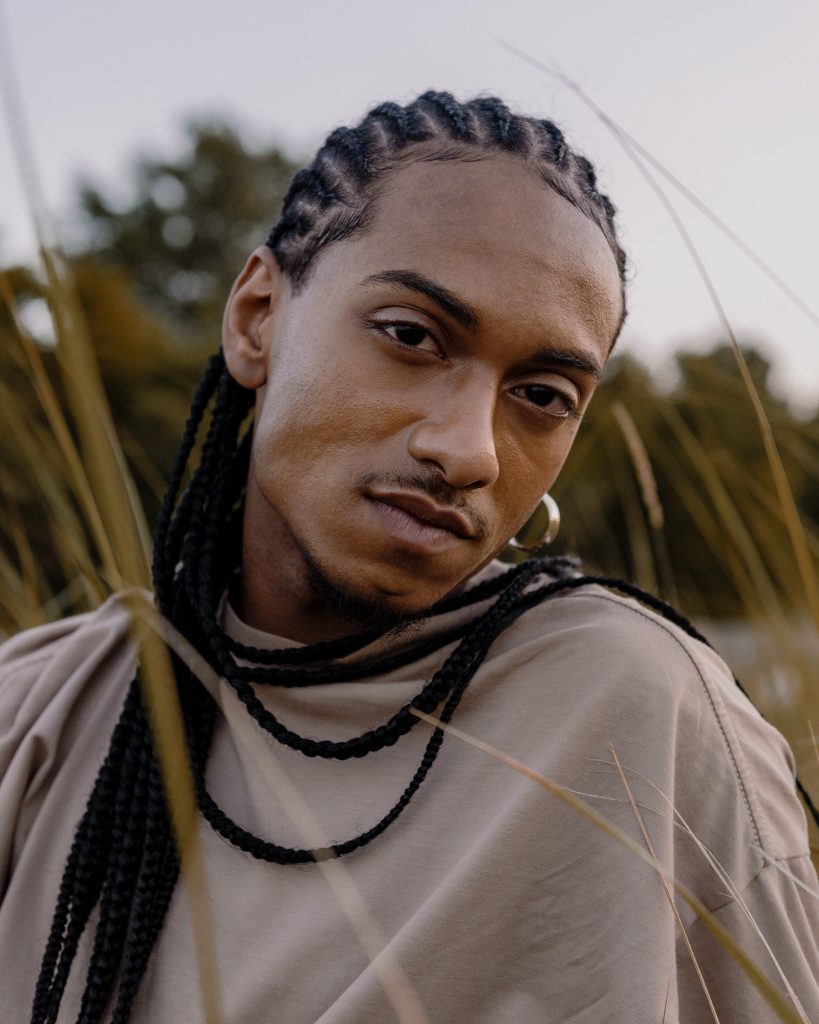
ST: That’s really interesting. I was thinking about how you address nightlife. I think nightlife and DJing are hard to talk or write about. Because you kind of ruin it by talking about it. Because it’s ephemeral—that’s the point of it. It happens at night for a reason. But then I find myself wanting to write about it or make art about nightlife—these kinds of ephemeral ways of being. What’s compelling to you about the ephemeral? What’s compelling to you about nightlife?
M: Yeah, definitely. For sure, I definitely draw a lot of inspiration from nightlife. It really is the ephemerality of it all. I think those spaces are inherently queer spaces—just because they only exist not so often, it’s not a permanent space. So it’s always changing. The work that I’m doing now is about transformation and death—attributing the hurricane, or a hurricane as this force and space for difference. Specifically the queer spaces that I’m thinking about—like raves—is really what I’m trying to get at when I say queer nightlife. Because those are spaces of difference. Those are spaces where people can feel communal. You can feel community. You can be so different from everybody else. It’s not about being the same. I think that is something that I’m trying to extrapolate. I’m trying to create communities of difference or create difference that is also community-based. Also, the spectacle of nightlife and how that gets into a lot of different things. I read this book by Debord called “Society of the Spectacle.” I was trying to cite that—I honestly can’t remember what I was trying to say [Laughs].
ST: That’s interesting, trying to create a community of difference is hard. Because these spaces, even subcultures develop norms.
M: I think there’s a queer norm, too.
ST: Yeah.
M: The thing about queerness is it’s always changing. It’s not about being stagnant. But there is always a status quo in all of that. So it’s hard to engage with that in general. I think all of us want to have a definition of what things look like so that we can understand it. I don’t think anybody’s comfortable with not understanding something. And understanding can be good and is good. Misunderstanding is what creates problems. A lot of times, in terms of queerness and Blackness, people think that understanding those things is what’s fixing the issue but that’s not fixing an issue. I think that’s working against the very nature of Blackness and the very nature of queerness because both things are very ephemeral. Both things are very fugitive to becoming fixed. I think that we need to further complicate it and continue to work with the nature of it so it can be much more harmonious. But I don’t know how that works. I think a lot of queerness is in opposition of the status quo of society or just like what is acceptable or understood as familiar. I think it’s a very dangerous space but I want to figure it out.
I think it’s very much in the here and that’s what I’m trying to do with my work. A breath of that comes into the music I pick out or the sound I engage with in my sets. I would like, in all honesty, I feel like I’m getting booked more for the stuff I want to play. When I was beginning it was more so like parties, much more centered around making people dance. After a while of doing that, I’m like, fuck yeah, I just want to do what I want and continue to create these narratives—these stories.
In the Pride South Side festival, I’m engaging with a lot of sound I don’t usually engage with. I found some hella house music and trancey stuff. I don’t usually engage with those. I engage with house sometimes, but not that much. But also just thinking about a narrative that I can further my identity with. Further Morenxxx with.
ST: Morenxxx worldwide.
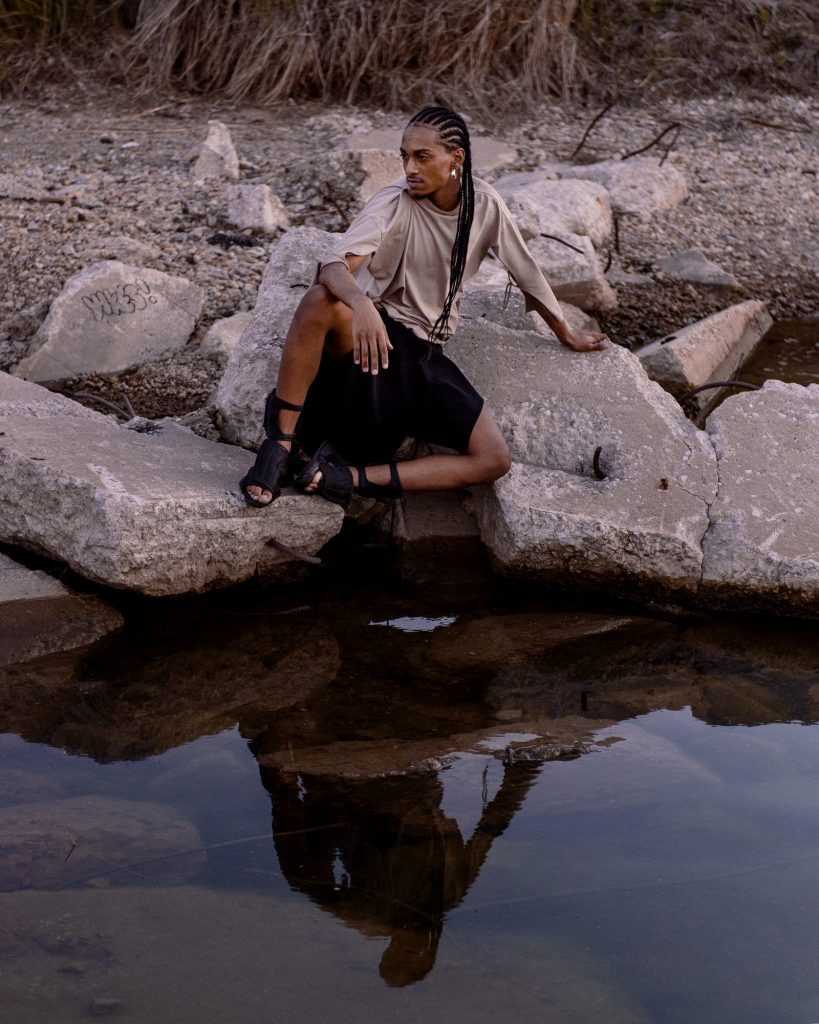
M: Yeah Morenxx worldwide [Laughs] Then there’s parties like– I don’t want to throw shade–
ST: You don’t have to name names.
M: There’s some parties where it’s much more centered around gayness—like we’re just going to be gay today and play gay music.
ST: What do you do about that? Do you still play whatever you want to play?
M: I think I play stuff people want to hear. And I have to be aware of that because some people don’t want to be exposed to new music and just hear stuff that they already know. So knowing that I want to hear stuff that I haven’t heard—there’s just two different kinds of people. I try to play around. I was talking to Talia Paul, who’s a DJ based in New York. She was saying you have to find the balance between the unknown and the known so that people can enjoy things they don’t know. But then some people just want—what was the last thing someone asked me to play? I forget what it was—I was playing some techno and someone was like, “Can you play some Lana del Ray?” Yeah, it was Lana del Ray. And I was like hello, no, I’m not ever playing Lana del Rey. You better take that somewhere else. [Laughs]
ST: [Laughs] They did not read the situation.
M: No.
ST: What kinds of other reactions do you get from people that aren’t just, like, ridiculous like that? It sounds like you’re intentionally trying to bring people out of their comfort zones. I don’t know if you get that many responses from people, but what do you get?
M: I’m trying to think—what are my responses? I get a lot of good responses. When I look at the videos—during the set it’s hard to really take in what’s happening all the time, cause you have to be focused on the sound. But in my last set at Abyss, that was so fun. I’m going to play that audio recording, but there’s this video that my friend took. I just think it’s wildness. It’s the spiral embodied.
[Laughs]
This man gave me 20 dollars as a tip during that night. It was really wild. That’s what I want. I want screaming, I want whistle blowing, I want clapping. I want all of that. So I really try to get to that, but that’s not an always thing.
Featured Image: Morenxxx sits gracefully in tall grasses, their hand resting on their forehead. Photo by Ryan Edmund.


Starting from the proposition that art-making is world-making, Sasha Tycko combines community organizing and curatorial work with writing, music, and performance. Tycko is a founding editor of The Sick Muse zine and an administrator of the F12 Network, a DIY collective that addresses sexual violence in arts communities. IG: @t_cko. www.sashatycko.net. Photo by ColectivoMultipolar.
